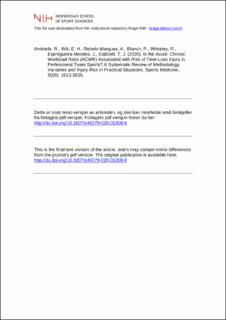| dc.contributor.author | Andrade, Renato | |
| dc.contributor.author | Wik, Eirik Halvorsen | |
| dc.contributor.author | Rebelo-Marques, Alexandre | |
| dc.contributor.author | Blanch, Peter | |
| dc.contributor.author | Whiteley, Rod | |
| dc.contributor.author | Espregueira-Mendes, João | |
| dc.contributor.author | Gabbett, Tim J. | |
| dc.date.accessioned | 2021-06-07T07:41:23Z | |
| dc.date.available | 2021-06-07T07:41:23Z | |
| dc.date.created | 2020-09-09T16:55:59Z | |
| dc.date.issued | 2020 | |
| dc.identifier.citation | Sports Medicine. 2020, 50, 1613-1635. | en_US |
| dc.identifier.issn | 0112-1642 | |
| dc.identifier.uri | https://hdl.handle.net/11250/2758083 | |
| dc.description | Dette er siste tekst-versjon av artikkelen, og den kan inneholde små forskjeller fra forlagets pdf-versjon. Forlagets pdf-versjon finner du her: http://dx.doi.org/10.1007/s40279-020-01308-6 / This is the final text version of the article, and it may contain minor differences from the journal's pdf version. The original publication is available here: http://dx.doi.org/10.1007/s40279-020-01308-6 | en_US |
| dc.description.abstract | Background: The acute: chronic workload ratio (ACWR) is an index of the acute workload relative to the cumulative chronic workloads. The monitoring of physical workloads using the ACWR has emerged and been hypothesized as a useful tool for coaches and athletes to optimize performance while aiming to reduce the risk of potentially preventable load-driven injuries. Objectives: Our goal was to describe characteristics of the ACWR and investigate the association of the ACWR with the risk of time-loss injuries in adult elite team sport athletes. Data sources: PubMed, EMBASE and grey literature databases; inception to May 2019. Eligibility criteria: Longitudinal studies that assess the relationship of the ACWR and time-loss injury risk in adult professional or elite team sports. Methods: We summarized the population characteristics, workload metrics and ACWR calculation methods. For each workload metric, we plotted the risk estimates for the ACWR in isolation, or when combined with chronic workloads. Methodological quality was assessed using a modified version of the Downs and Black scale. Results: Twenty studies comprising 2375 injuries from 1234 athletes (all males and mean age of 24 years) from different sports were included. Internal (65%) and external loads (70%) were collected in more than half of the studies and the session-rating of perceived exertion and total distance were the most commonly collected metrics. The ACWR was commonly calculated using the coupled method (95%), 1:4 weekly blocks (95%) and subsequent week injury lag (80%). There were 14 different binning methods with almost none of the studies using the same binning categories. Conclusion: The majority of studies suggest that athletes are at greater risk of sustaining a time-loss injury when the ACWR is higher relative to a lower or moderate ACWR. The heterogenous methodological approaches not only reflect the wide range of sports studied and the differing demands of these activities, but also limit the strength of recommendations. | en_US |
| dc.language.iso | eng | en_US |
| dc.subject | adult | en_US |
| dc.subject | athletic injuries / epidemiology | en_US |
| dc.subject | humans | en_US |
| dc.subject | male | en_US |
| dc.subject | risk factors | en_US |
| dc.subject | team sports | en_US |
| dc.subject | workload | en_US |
| dc.subject | young adult | en_US |
| dc.title | Is the Acute: Chronic Workload Ratio (ACWR) Associated with Risk of Time-Loss Injury in Professional Team Sports? A Systematic Review of Methodology, Variables and Injury Risk in Practical Situations | en_US |
| dc.type | Peer reviewed | en_US |
| dc.type | Journal article | en_US |
| dc.description.version | acceptedVersion | en_US |
| dc.source.pagenumber | 1613-1635 | en_US |
| dc.source.volume | 50 | en_US |
| dc.source.journal | Sports Medicine | en_US |
| dc.identifier.doi | 10.1007/s40279-020-01308-6 | |
| dc.identifier.cristin | 1828519 | |
| dc.description.localcode | Institutt for idrettsmedisinske fag / Department of Sports Medicine | en_US |
| cristin.ispublished | true | |
| cristin.fulltext | postprint | |
| cristin.qualitycode | 1 | |
